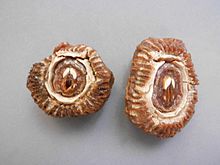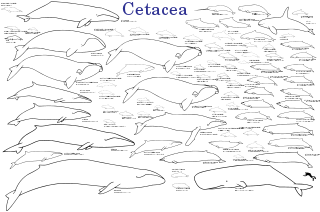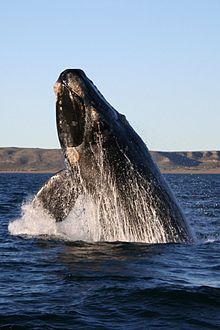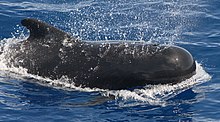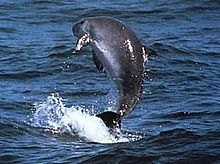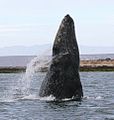The Cetaceans Portal

Cetacea ( /sɪˈteɪʃə/; from Latin cetus ' whale', from Ancient Greek κῆτος ( kêtos) ' huge fish, sea monster') is an infraorder of aquatic mammals belonging to the order Artiodactyla that includes whales, dolphins, and porpoises. Key characteristics are their fully aquatic lifestyle, streamlined body shape, often large size and exclusively carnivorous diet. They propel themselves through the water with powerful up-and-down movement of their tail which ends in a paddle-like fluke, using their flipper-shaped forelimbs to maneuver.
While the majority of cetaceans live in marine environments, a small number reside solely in brackish water or fresh water. Having a cosmopolitan distribution, they can be found in some rivers and all of Earth's oceans, and many species inhabit vast ranges where they migrate with the changing of the seasons.
Cetaceans are famous for their high intelligence, complex social behaviour, and the enormous size of some of the group's members. For example, the blue whale reaches a maximum confirmed length of 29.9 meters (98 feet) and a weight of 173 tonnes (190 short tons), making it the largest animal known ever to have existed.
There are approximately 89 living species split into two parvorders: Odontoceti or toothed whales (containing porpoises, dolphins, other predatory whales like the beluga and the sperm whale, and the poorly understood beaked whales) and the filter feeding Mysticeti or baleen whales (which includes species like the blue whale, the humpback whale and the bowhead whale). Despite their highly modified bodies and carnivorous lifestyle, genetic and fossil evidence places cetaceans as nested within even-toed ungulates, most closely related to hippopotamus within the clade Whippomorpha. ( Full article...)
Selected picture
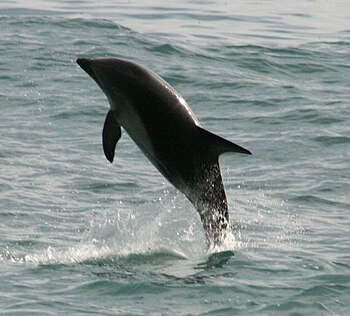
The Dusky Dolphin (Lagenorhynchus obscurus) is a highly gregarious and acrobatic dolphin found in coastal waters in the Southern Hemisphere. It was first identified by John Gray in 1828. It is very closely genetically related to the Pacific White-sided Dolphin, although current scientific consenus is that they are distinct species.
More did you know...

- ...the Orca, is the fastest swimmer of all the cetaceans and can reach speeds of more than 50 km/h (30 mph) while hunting.
- ...some cetaceans can dive to depths of more than one kilometre (0.6 mi) and stay there for more than an hour.
- ...newborn cetacean calves do not have the skills to swim for long periods or to accelerate away from danger, so they swim in the slipstream of their mothers, enabling the mother to protect her calf.
- ...all cetaceans have a blubber layer — a layer of fat under the skin. In most dolphins, this layer is about one quarter to one third of the total body weight, but in southern right whales nearly half of its weight (up to 50 tons) will be blubber.
- ...most whales and dolphins live long lives. Wild bottlenose dolphins live well into their forties, while some of the larger whales live in excess of 80 years!
Things you can do..
|
|
Here are some Cetaceans WikiProject tasks you can do.
|
General images -
Did you know (auto-generated)

- ... that one can swim with humpback whales in the Niue Nukutuluea Multiple-Use Marine Park?
- ... that the three dolphins on the coat of arms of Anguilla represent "unity, strength and endurance", which is also the motto of the territory?
- ... that Celia Kaye won the Golden Globe Award for Most Promising Newcomer in 1965 for her starring role in Island of the Blue Dolphins?
- ... that the South Asian river dolphin is nearly blind and relies on echolocation for navigation?
- ... that one of the first researchers to propose dolphin-assisted therapy for humans later renounced it?
Selected media
List articles
Related portals
WikiProjects

The content you are reading was created by Wikipedia volunteers. See WikiProject Cetaceans for more.
- See also: Wikispecies, a Wikimedia project dedicated to the classification of species.
Cetacean articles
Categories
For additional lists of marine life-related featured articles and good articles see:
Associated Wikimedia
The following Wikimedia Foundation sister projects provide more on this subject:
-
Commons
Free media repository -
Wikibooks
Free textbooks and manuals -
Wikidata
Free knowledge base -
Wikinews
Free-content news -
Wikiquote
Collection of quotations -
Wikisource
Free-content library -
Wikispecies
Directory of species -
Wikiversity
Free learning tools -
Wikivoyage
Free travel guide -
Wiktionary
Dictionary and thesaurus



